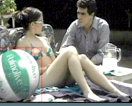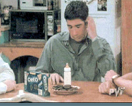



Baseball fans at the 2002 World Series between the Giants and the Angels did not see what fans at home saw on their TV’s. To crowds in the stands, there was not much interesting behind home plate. But TV viewers saw different virtual advertisements every half-inning. Before the World Series though, football fans saw this technology first used to create the virtual yellow line that helps viewers distinguish the first-down line.
This revolution in TV advertising may have begun by enhancing live sports, but it is quickly branching out into virtual advertising, such as insertion of virtual signs, banners, logos and the placement of virtual products into TV shows. This rapidly developing technology is prompting significant ethical question, such as, is virtual advertising deceptive? Let’s begin with a brief description of the technology behind virtual advertising and why it is as popular as it is controversial. Virtual advertising is a purely ethical issue, and I will outline its importance.
WHAT IS VIRTUAL ADVERTISING?
The “Live Video Insertion System” known as L-VIS is a “proprietary technology that interrupts the broadcast feed and inserts electronic images in real time into any video stream.” (Grossman, 2000). A high-tech marketing firm in New Jersey, Princeton Video Image, or PVI, is one of the creators of L-VIS. CEO and president of PVI, Dennis Wilkinson, says of the technology, “We are able to digitally alter images to make it look and feel like it’s really there.”
That altering of reality has put Wilkinson and his L-VIS system in the midst of controversy. During CBS’s 2000 New Year’s Eve telecast from Times Square, L-VIS was used to superimpose the CBS logo on a billboard—a billboard advertising NBC. CBS also blotted out a real billboard for Budweiser and digitally substituted its own logo on One Times Square, the building where the ball drops at midnight. Dan Rather later said it was a “mistake.” Critics charged that by doctoring reality, CBS News compromised its journalistic integrity.
Virtual signage is just the beginning. It is “virtual product placement” that promises to cause controversy as realistic computer generated images of brand-name products can be inserted into live broadcasts or recorded programs. L-VIS can insert cereal boxes, toothpaste tubes and soda cans in recorded shows (see image C, appendix A). The brands can change each time an episode airs, so a box of Special K on Friends next week could turn into Lucky Charms in reruns. (American Demographics). So, thanks to the marvels of virtual product placement, a desperate housewive’s coffee cup could become prime real estate.
WHY USE VIRTUAL ADS?
The competition for consumer attention amongst the plethora of media choices, hundreds of channels, increasing production costs, and the perceived decline in effectiveness of 30-second commercials have caused networks to embrace close relationships with advertisers who offer financial and marketing muscle. “With hundreds of channels being created, heavy demand for programming is raising the cost of advertising while audiences per channel decline.” (Tomkins, 2002).
One major factor in the attraction of virtual product placement is yet another recent technology, PVRs, or personal video recorders. PVRs, like TiVo, allow users to skip commercials, which has marketers worried. Of 112 marketers surveyed, 76% said they would reduce TV ad spending when PVRs reached 30 million homes. Many of the marketers surveyed said they would likely increase spending on program sponsorships and product placement deals. (Vranica, 2002).
Virtual Law and Ethics
While there has not been any debate on virtual product placement in the U.S., many media critics are concerned about the impact on viewer trust. ''It's about lying and cheating,'' said George Gerbner, communications theorist and professor at University of Pennsylvania. ''It takes advantage of the public's belief that a broadcast of a real event actually conveys what's going on.'' (Horovitz,2000). Editor of Broadcasting and Cable Magazine, Harry Jessell, says, “People have an expectation that a video will reflect reality. Changing it for commercial purposes is crossing the line.”
What makes this an ethical issue? So far, federal regulators are not interested in virtual product placement and have not ruled on it. The Federal Communications Commission does indeed have rules governing advertiser-supported placements. Shows must make full disclosure. This is as simple as a “promotional considerations” tag or rolling disclaimers in the credits. The Federal Trade Commission is actually the agency charged with policing advertising. In 1992, the Federal Trade Commission declined to issue any specific guidelines for product placement. The FTC released a statement that said, "Due to the apparent lack of a pervasive pattern of deception and substantial consumer injury attributable to product placements, the Commission has determined that an industry-wide rulemaking is inappropriate at this time." (FTC Release, 1992).
''It hasn't been a major issue,'' said Lee Peeler, associate director for advertising practices at the Federal Trade Commission. ''In looking at any advertising technology, what the FTC wants to know is: Does it misrepresent a material aspect of the product?'' The Federal Communications Commission has not received any complaints. Without any policy or regulation, virtual product placement can only be an ethical issue.
''It's a sneaky way to get your brand name in front of viewers,'' says Michael Jacobson, author of A Survival Guide for a Consumer Society. ''There's no label on it that says this is advertising.'' (Horovitz, 2002). Labeling is not a bad idea. Some European countries already require broadcasters to inform viewers whenever there are virtual ads in live sporting events. They must do so before and after the broadcast. (Horovitz, 2002).
The only similar disclosure in the U.S. is on CBS’s Early Show about once a week when show hosts will jokingly inform viewers that the Early Show logo just broadcast on the back of a horse-drawn carriage at Central Park was not a real logo.
Conclusion
"The networks are betraying their viewers with such blatant commercialization," said Michael Jacobson, executive director in Washington at the Center for Science in the Public Interest. (Stuart, 2001). Yet, can we accuse networks of betrayal if they do not even think of the audience as people? Networks view the audience as a commodity that they sell to the advertiser. How can you betray a commodity? In his book, Selling the Air, author Thomas Streeter writes, “One of the central incongruities of American broadcasting is that the audience is construed simultaneously as both subject and object of the system, both the buyer and the thing sold.” (Streeter, 1996).
As television and cable networks adopt new advertising models, it is crucial to prevent networks from casting aside stories that might not be as virtual product-placement “friendly” as others. Will they reject program ideas that do not as easily accommodate marketing? “Maybe other stories won’t be told because they aren’t as amenable to product placement,” says Thompson of Syracuse University.
Finally, what will happen when all the networks and their marketing partners are doing the same thing? This new model of advertising is meant to help advertisers stand out from the clutter of 30-second commercials. Yet, once the clutter increases within the shows, no one stands out and no one is above the clutter.
WORKS CITED
American Demographics. (2002, September). New fall TV shows. Retrieved on
November 28, 2002 from Academic Search Elite.
Eisenberg, D. (2002, September 2). It’s an ad ad ad world. Time. Retrieved on
November 20, 2002 from http://www.time.com/time/magazine/archives.
Federal Trade Commission. (1992, December 11). FTC denies CSC's petition to
promulgate rule on product placement in movies. Retrieved on December
1, 2002 from http://www.ftc.gov/opa/predawn/F93/csc-petit5.htm.
Friedman, W. (2002, October, 14). Buyers fret over failure of ‘Push, Nevada.’
Advertising Age, 73, p4. Retrieved on November 29, 2002 from Academic
Search Elite.
Gough, P. (2002, October 18). Virtual ads over the plate at world series.
MediaPost.com. Retrieved on November 28, 2002 from
http://www.mediapost.com/dtls_dsp_news.cfm?newsld=185050.
Grossman, B. (2000, February 2). Now you see it, now you don’t. Daily
Princetonian. Retrieved on November 20, 2002 from
http://www.dailyprincetonian.com/Content/2000/02/02/page3/8.html
Horovitz, B. (2000, June 7). Digital ads bend reality. USA Today. Retrived on
November 28, 2002 from Academic Search Elite.
McCarthy, M. (2001, March 23). Ads show up in unexpected places. USA
Today. Retrieved on November 20, 2002 from http://usatoday.com/life/television/front.htm.
.
Stanley, T.L. (2002, May 13). Prime time for sale. MediaWeek.
Streeter, T. (1996). Selling the air: A critique of the policy of commercial
broadcasting in the United States. Chicago: University of Chicago Press.
Stuart, E. (2001, May 23). Advertising: Reruns may become testing ground for
digital insertion. The New York Times. Retrieved on November 28, 2002
from http://myphlip.pearsoncmg.com/cw/mpviewce.
Tomkins, R. (2002, November 4). Advertisers demand more dominant role in TV.
Financial Times.
Vranica, S. (2002, November 26). If U.S. viewers zap ads, so will advertisers.
The Wall Street Journal.
Virtual Palmolive Beachball

Pepsi virtually inserted on soccer field

